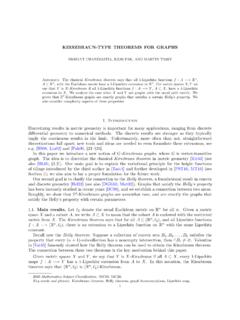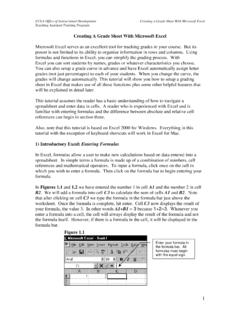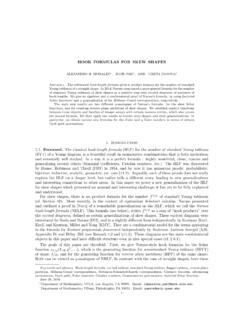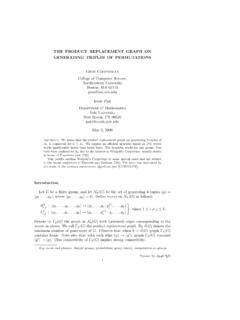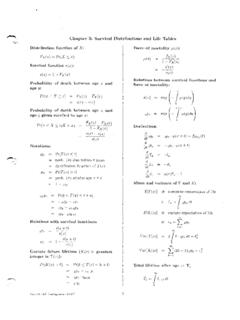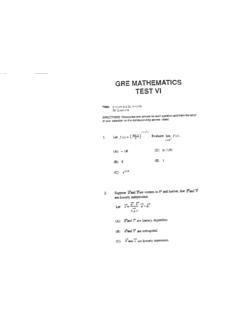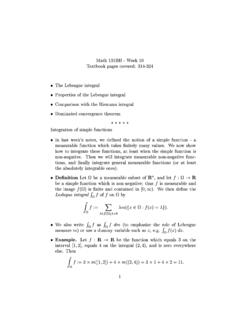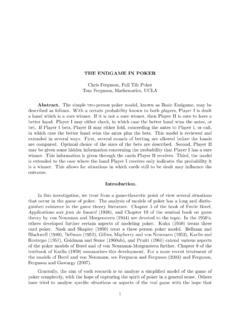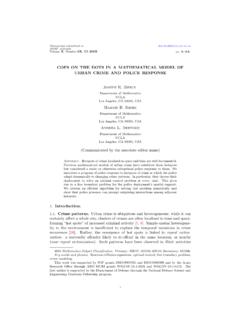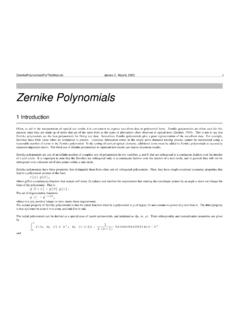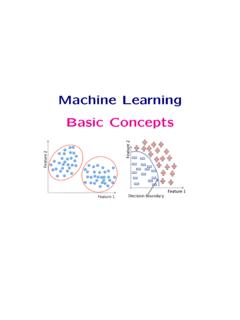Transcription of HARMONIC ANALYSIS - UCLA Mathematics
1 HARMONIC ANALYSISTERENCE TAOA nalysis in general tends to revolve around the study of general classes offunc-tions(often real-valued or complex-valued) andoperators(which take one or morefunctions as input, and return some other function as output). HARMONIC analysis1focuses in particular on thequantitativeproperties of such functions, and how thesequantitative properties change when apply various (often quite explicit) good example of a quantitative property is for a functionf(x) being uniformlybounded in magnitude by an explicit upper boundM, or perhaps being squareintegrable with some boundA, thus |f(x)|2dx A. A typical question in har-monic ANALYSIS might then be the following: if a functionf:Rn Ris squareintegrable, and its gradient fexists and is also square integrable, does this implythatfis uniformly bounded?
2 (The answer is yes whenn= 1, no whenn>2, andjust barely no whenn= 2; this is a special case of theSobolev embedding theorem,which is of fundamental importance in the ANALYSIS of PDE.) If so, what are theprecise bounds one can obtain?Real and complex functions, such as a real-valued functionf(x) of one real variablex R, are of course very familiar in Mathematics , starting back in high school. Inmany cases one deals primarily withspecial functions- polynomials , exponentials,trigonometric functions, and other very explicit and concrete functions. Such func-tions typically have a very rich algebraic and geometric structure, and there aremany techniques from those fields of Mathematics that can be used to give exactsolutions to many questions concerning these contrast, ANALYSIS is more concerned withgeneralclasses of functions - functionswhich may have some qualitative property such as measurability, boundedness,continuity, differentiability, smoothness, analyticity, integrability, decay at infinity,etc.
3 , but which cannot be usefully expressed as a special function, and thus has littleor no algebraic or geometric structure. These types of generic functions occur quitefrequently for instance in the study of ordinary and partial differential equations,since the solutions to such equations often cannot be given in an explicit algebraicform, but are nevertheless known to obey various qualitative properties such asdifferentiability. In other cases, the functions can be very explicit and structured,but for one reason or another it is difficult to exploit this structure in a purelyalgebraic manner, and one must rely (at least in part) on more analytical tools1 Strictly speaking, this sentence describes the field ofreal-variable HARMONIC ANALYSIS . Thereis another field ofabstract HARMONIC ANALYSIS , which is primarily concerned with how real orcomplex-valued functions (often on very general domains) can be studied using symmetries suchas translations or rotations (for instance via the Fourier transform and its relatives); this field is ofcourse related to real-variable HARMONIC ANALYSIS , but is perhaps closer in spirit to representationtheory and functional ANALYSIS , and will not be discussed TAOinstead.
4 A typical example is the Airy function Ai(x) := ei(x + 3)d , whichis given as an explicit integral, but in order to understand such basic questionsas whether Ai(x) is always a convergent integral, and whether this integral goesto zero asx , it is easiest to proceed using the tools of HARMONIC this case, one can use theprinciple of stationary phaseto answer both thesequestions affirmatively, although there is the perhaps surprising fact that the Airyfunction decays almost exponentially fast asx + , but only polynomially fastasx . HARMONIC ANALYSIS , as a sub-field of ANALYSIS , is particularly interested in the studyof quantitative bounds on these functions. For instance, instead of merely assumingthat a functionfis bounded, one could askhowbounded it is - in particular, whatis the best boundM 0 available such that|f(x)| Mfor all (or almost all)x R; this number is known as thesup normorL normoffand is denoted f L.
5 Or instead of assuming thatfis absolutely integrable, one can quantify thisby introducing theL1norm f L1:= |f(x)|dx; more generally one can quantifypth-power integrability for 0<p< via theLpnorm f Lp:= ( |f(x)|pdx)1 , most of the other qualitative properties mentioned above can be quan-tified by a variety ofnorms, which assign a non-negative number (or + ) to anygiven function and which provide some quantitative measure of one characteristic ofthat function. Besides being of importance in pure HARMONIC ANALYSIS , quantitativeestimates involving these norms are also useful in applied Mathematics , for instancein performing an error ANALYSIS of some numerical tend to have infinitely many degrees of freedom, and it is thus unsur-prising that the number of norms one can place on a function are similarly infinite;there are many ways one can quantify how large a function is.
6 These norms canoften differ quite dramatically from each other. For instance, it is possible for afunctionfto have largeL norm but smallL1norm (think of a very spiky functionwhich is large on a very small set, but zero elsewhere), or conversely to have smallL norm but largeL1norm (think of a very broad function which is very smallbut spread out over a very large set). Similarly if one compares theL2norm withtheL1orL norms. However, it turns out that theL2norm lies in some sense between theL1andL norms, in the sense that if one controlsboththeL1andL norms, then one also automatically controls theL2norm. Intuitively, the pointis thatL control eliminates all the spiky functions, andL1control eliminates mostof the broad functions, and the remaining functions end up being well behaved inthe intermediate normL2.
7 More quantitatively, we have the inequality f L2 f 1/2L1 f 1/2L which is a simple consequence of the algebraic fact that if|f(x)| M, then|f(x)|2 M|f(x)|. This is a special case ofH older s inequality, which is one ofthe fundamental inequalities in HARMONIC ANALYSIS ; the idea that control of two ex-treme norms automatically implies further control on intermediate norms can begeneralized tremendously and leads to the very powerful and convenient methodsofinterpolation theory, which is another basic tool in HARMONIC ANALYSIS3 The study of a single function and all its norms eventually gets somewhat tire-some, though. As in many other fields of Mathematics , the subject gets a lot moreinteresting when one not only considers these objects (functions) in isolation, butalso introducesmapsfrom one object to another; these maps, which take one (ormore) functions as input and returns another as output, are usually referred to asoperatorsortransforms.
8 Operators may seem like fairly complicated mathematicalobjects - after all, their inputs and outputs are functions, which in turn have in-puts and outputs which are usually numbers - however they encode many naturaloperations one performs on these functions, such asdifferentiationf(x)7 ddxf(x)and its well-known (partial) inverse,integrationf(x)7 x f(y) less intuitive, but particularly important, example is theFourier transformf(x)7 f(x) := e 2 ixyf(y)dy.(1)It is also of interest to consider operators which take two or more inputs; twoparticularly common examples arepointwise product(f(x),g(x))7 f(x)g(x),andconvolution(f(x),g(x))7 f g(x) := f(y)g(x y) are of course many other operators of interest in HARMONIC ANALYSIS . His-torically, HARMONIC ANALYSIS was first concerned with the operations that were con-nected to Fourier ANALYSIS , real ANALYSIS , and complex ANALYSIS ; nowadays, however,the methods of HARMONIC ANALYSIS have been brought to bear on a much broaderset of operators.
9 These techniques have been particularly fruitful in understandingthe solutions of various linear and non-linear partial differential equations (withthe solution being viewed as an operator applied to the initial data), as well as inanalytic and combinatorial number theory, when one is faced with understandingthe oscillation present in various expressions such as exponential sums. Harmonicanalysis has also been applied to analyze operators which arise in geometric mea-sure theory, probability theory, ergodic theory, numerical ANALYSIS , and primary concern of HARMONIC ANALYSIS is in obtaining both qualitative and quan-titative information about how these sorts of operators act on generic functions. Atypical example of a quantitative estimate is the inequality f g L f L2 g L2for allf,g L2, which is a special case of Young s inequality and is easily provenusing the Cauchy-Schwarz inequality; as a consequence of this we have the qualita-tive conclusion that the convolution of twoL2functions is necessarily continuous(this is basically because the continuous functions form a closed subspace ofL ,and becauseL2functions can be approximated to arbitrary accuracy by smooth,compactly supported functions).
10 We give some further examples of qualitative andquantitative ANALYSIS of operators in the next : Fourier summationTo illustrate the interplay between quantitative and qualitative results, we sketchsome of the basic theory of summation of Fourier series, which historically was oneof the main motivations for studying HARMONIC ANALYSIS in the first this section, the functionfunder consideration will always be assumed be pe-riodic with period 2 , thusf(x+ 2 ) =f(x) for allx; for instance,fcould bea trigonometric polynomial such asf(x) = 3 + sin(x) 2 cos(3x). Iffis also acontinuous function (or at least an absolutely integrable one), then we can definethe Fourier coefficients f(n) for all integersnby the formula f(n) :=12 2 0f(x)e theory of Fourier series then suggests one has the identityf(x) = n= f(n)einxbut the rigourous justification of this identity requires some effort.
